
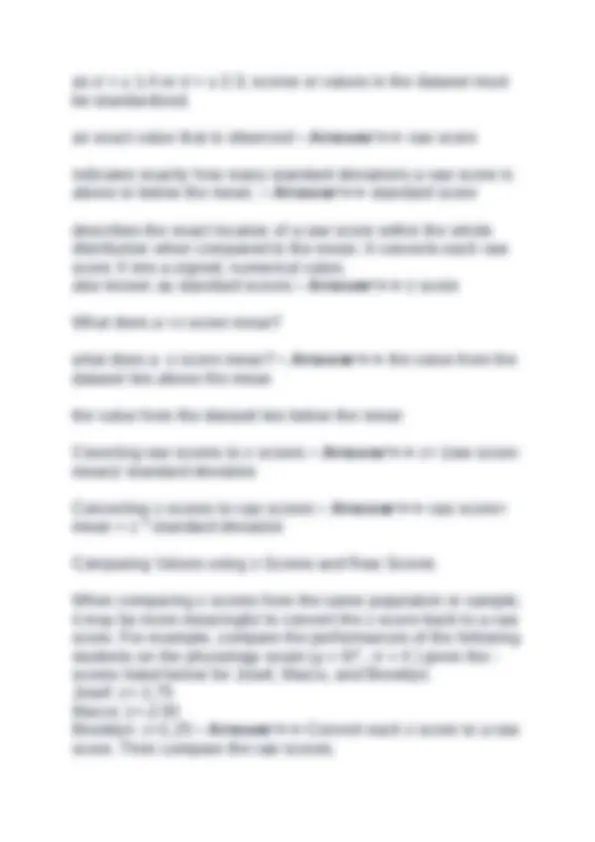
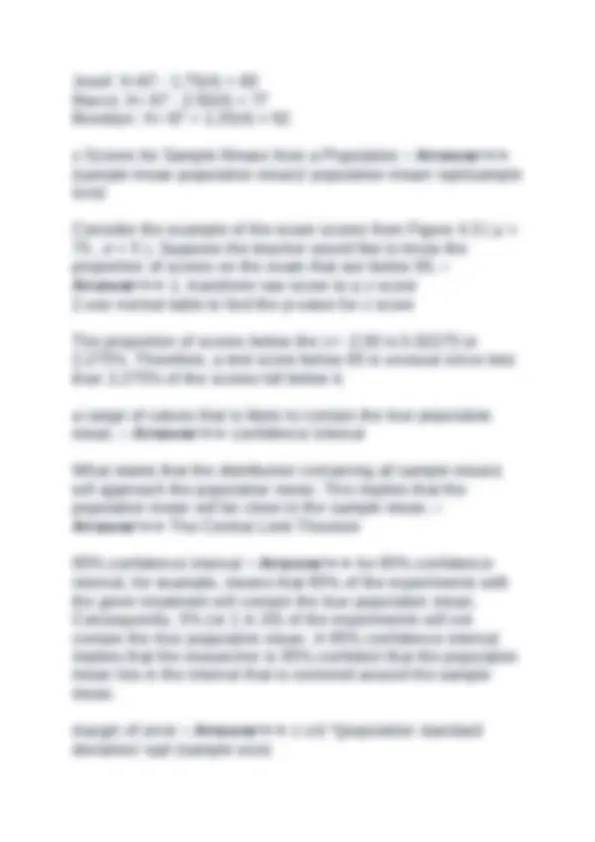

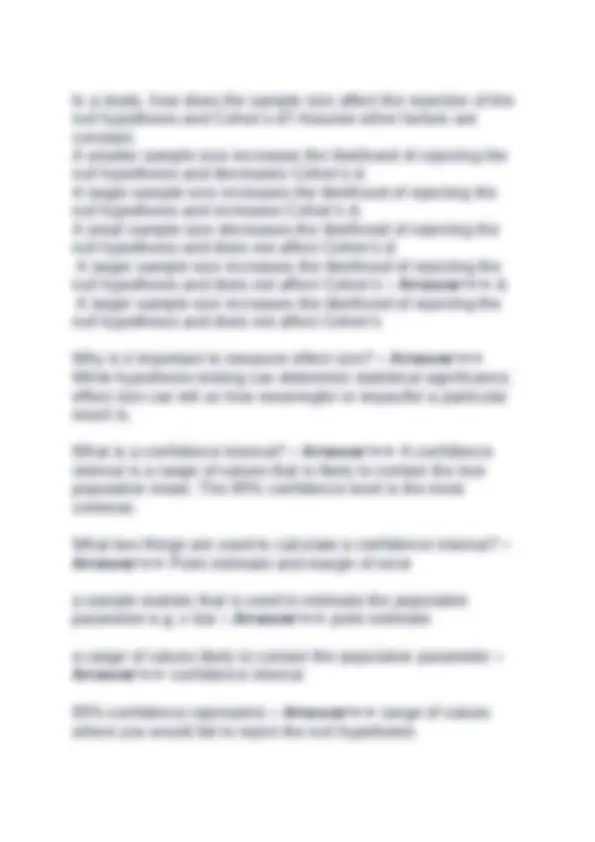
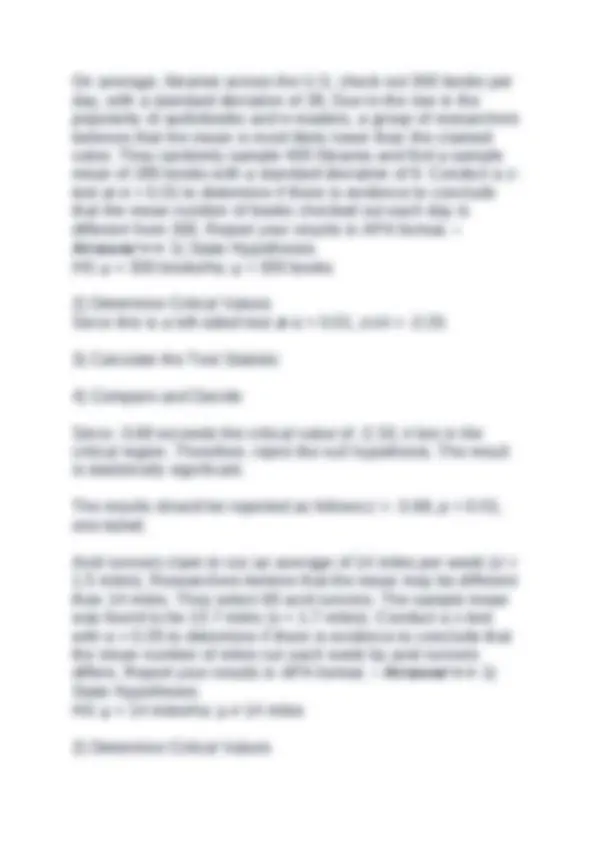
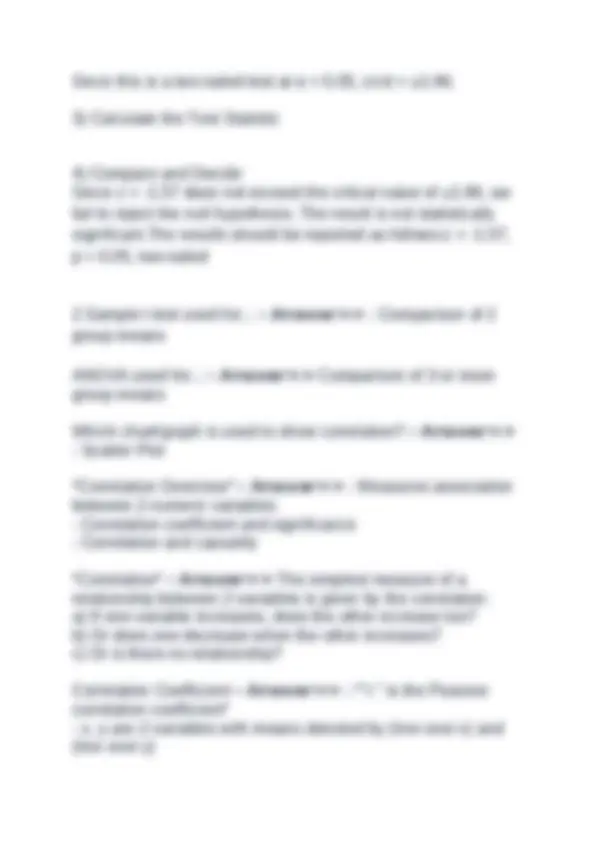
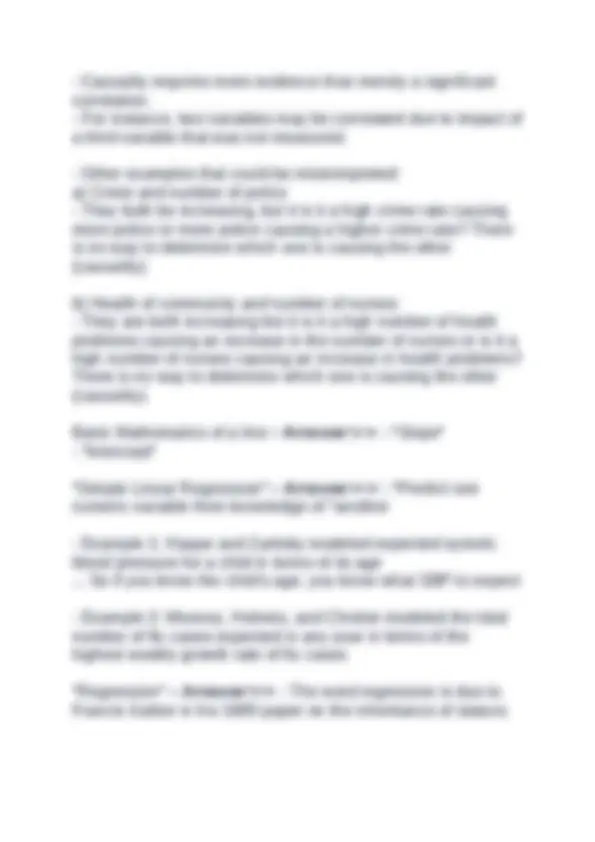
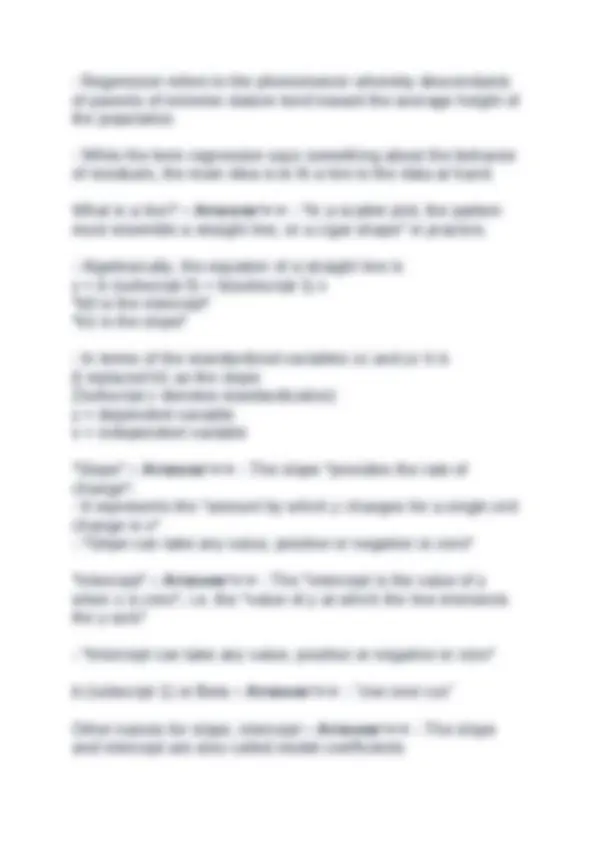
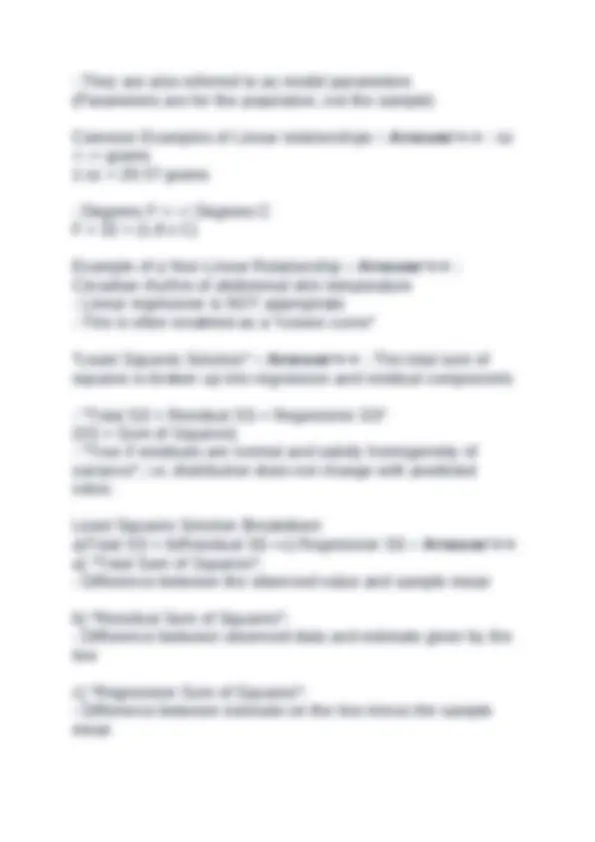
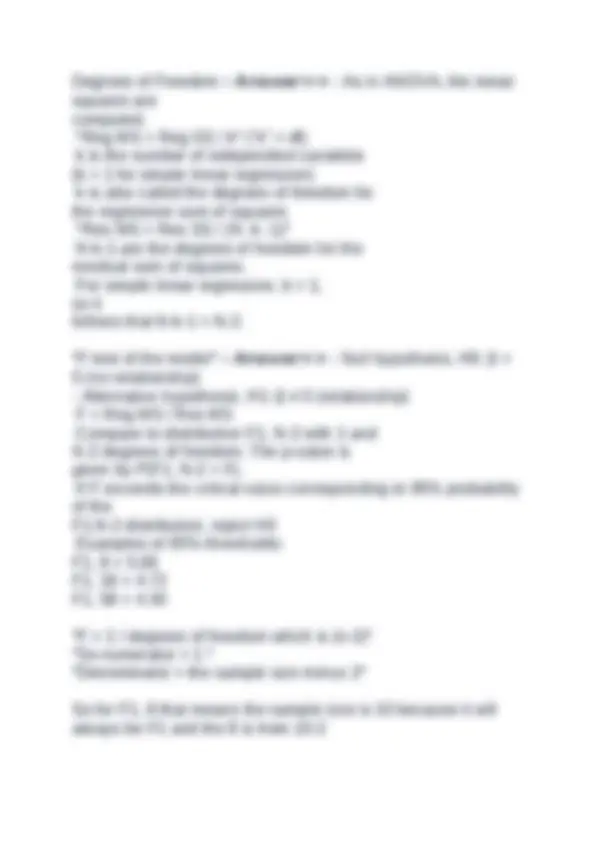
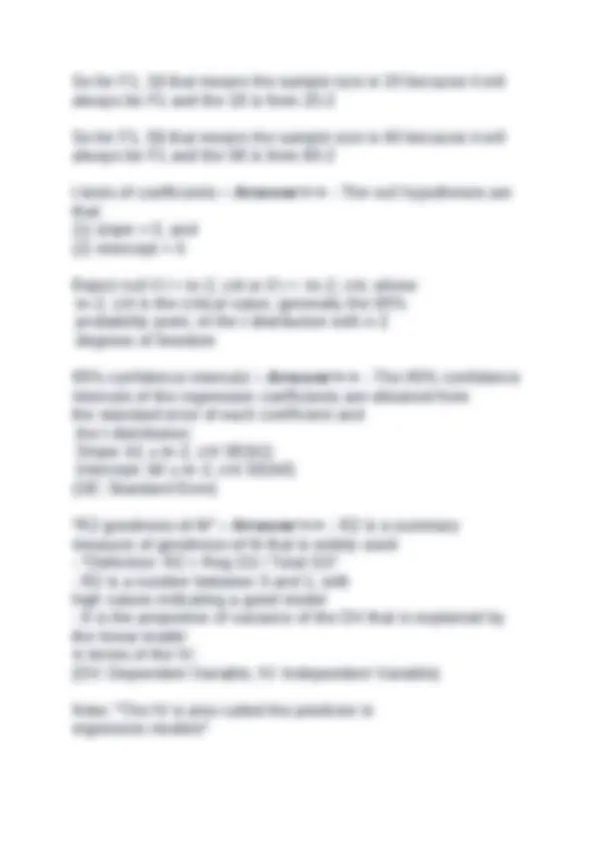
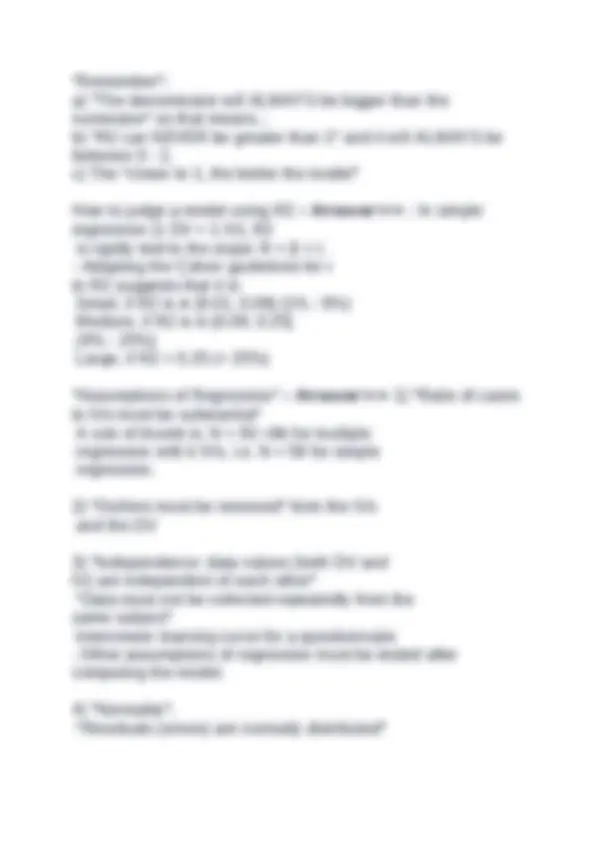
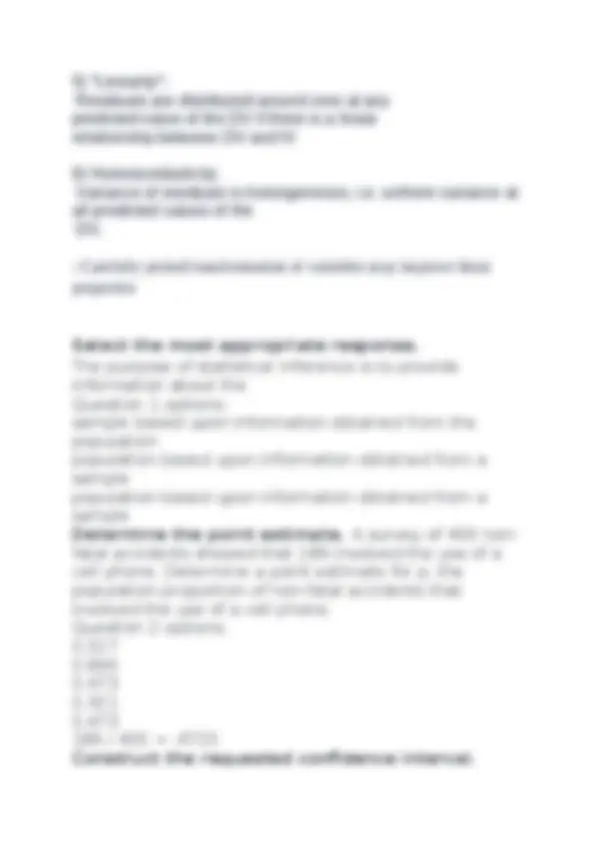
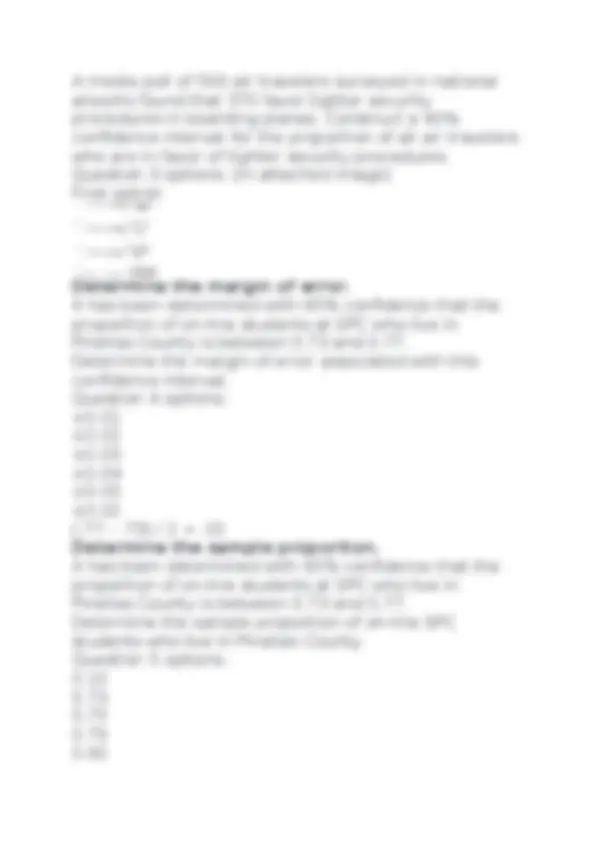
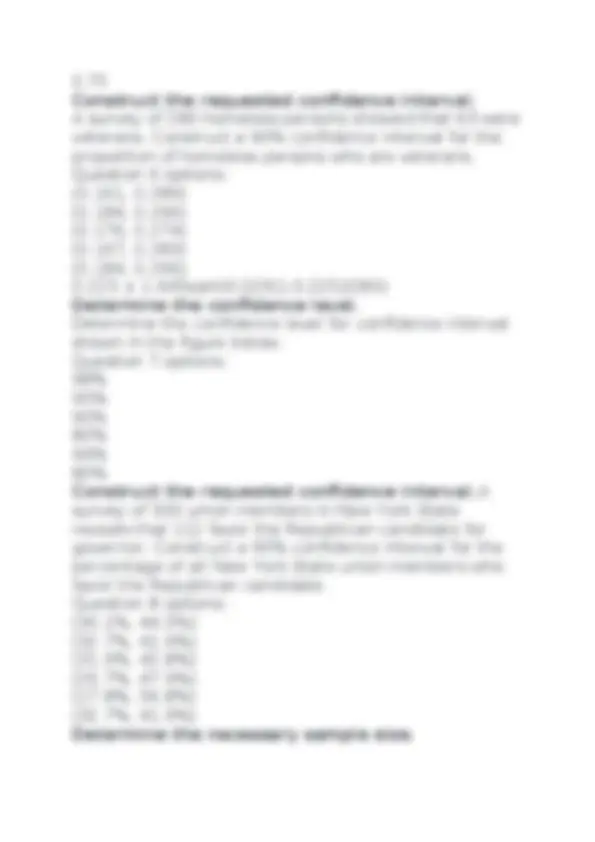
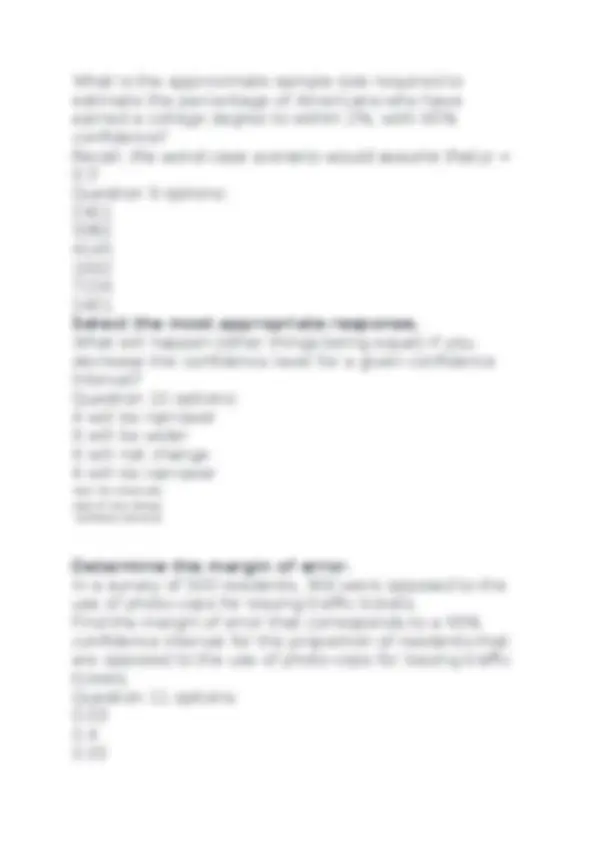
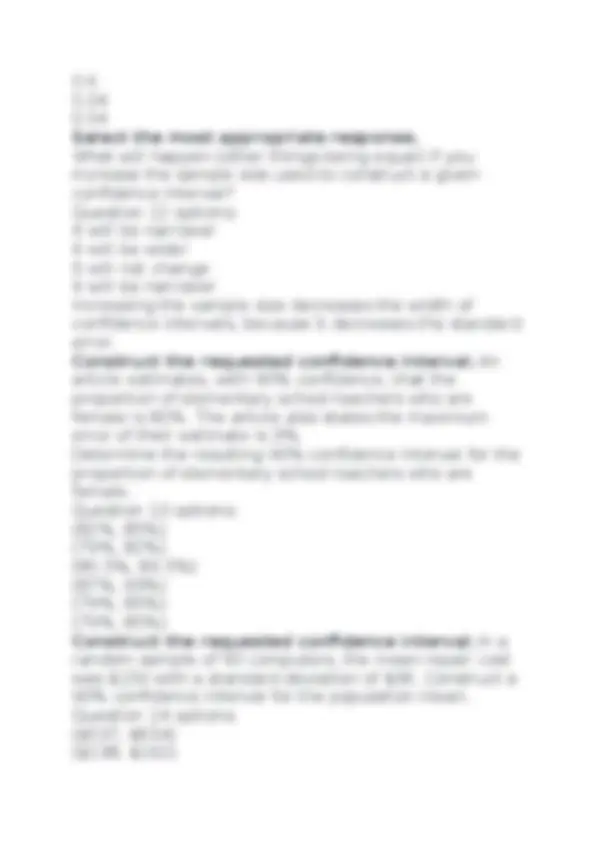
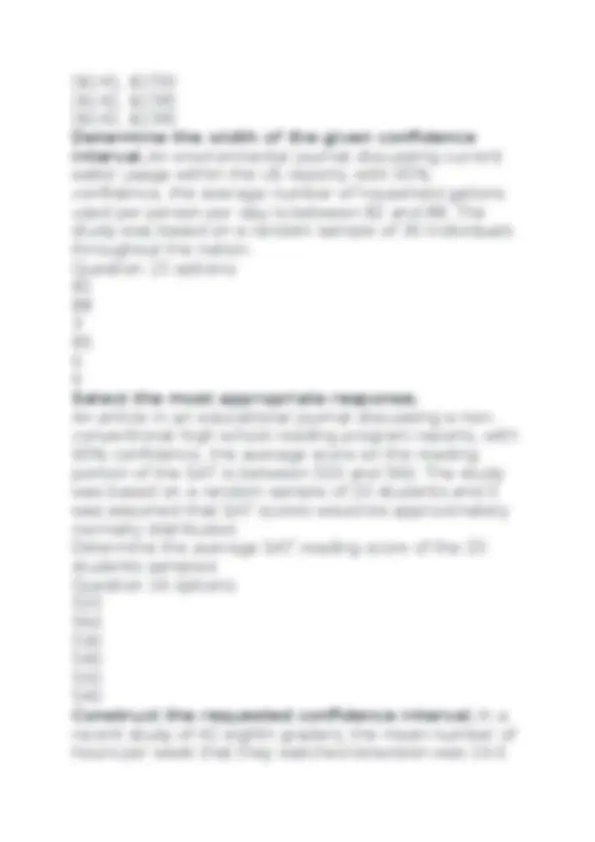
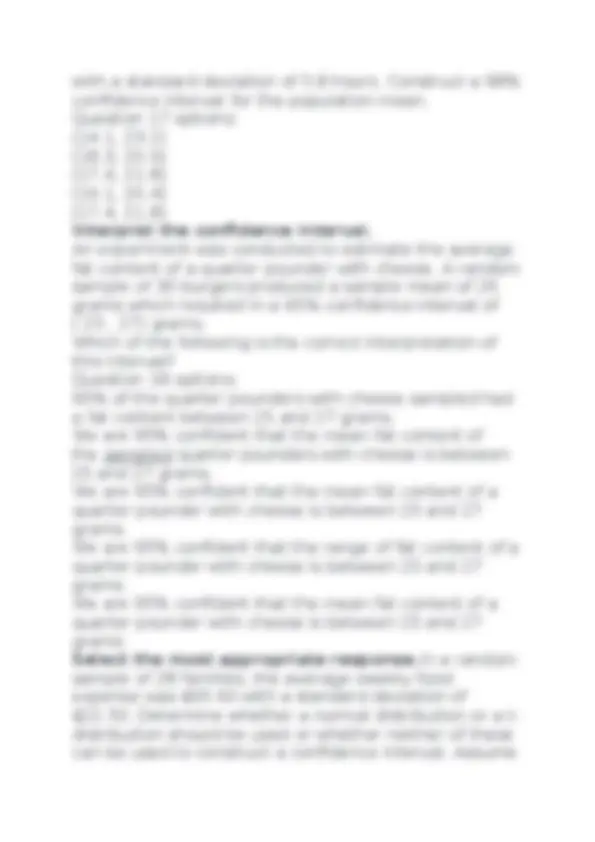
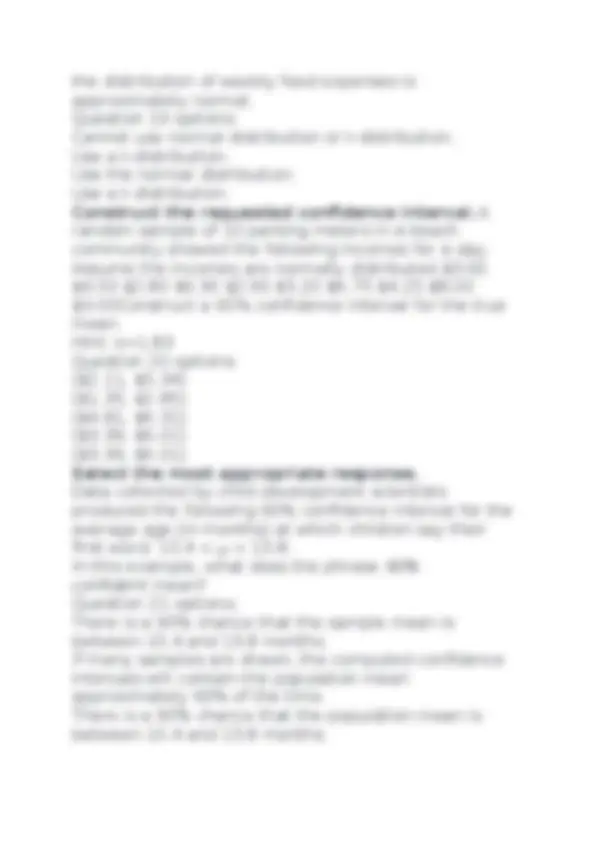
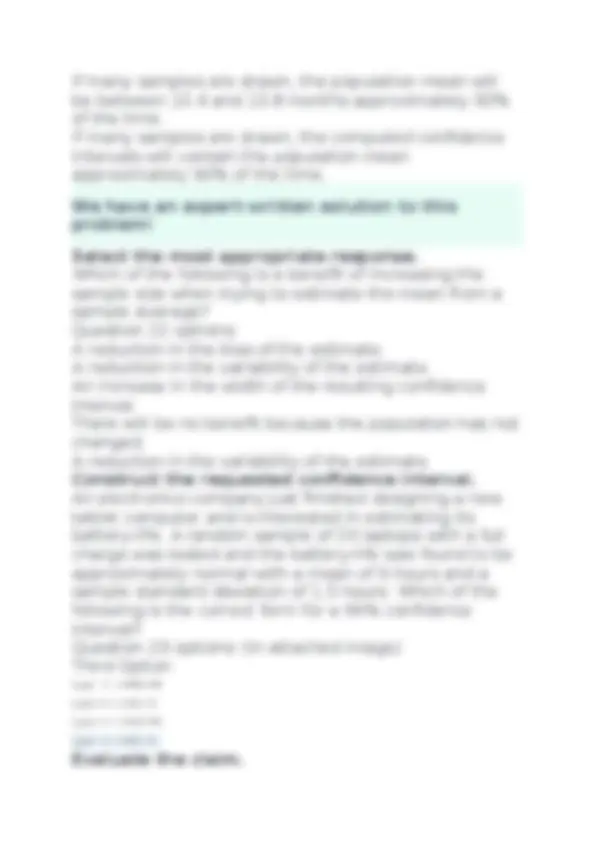
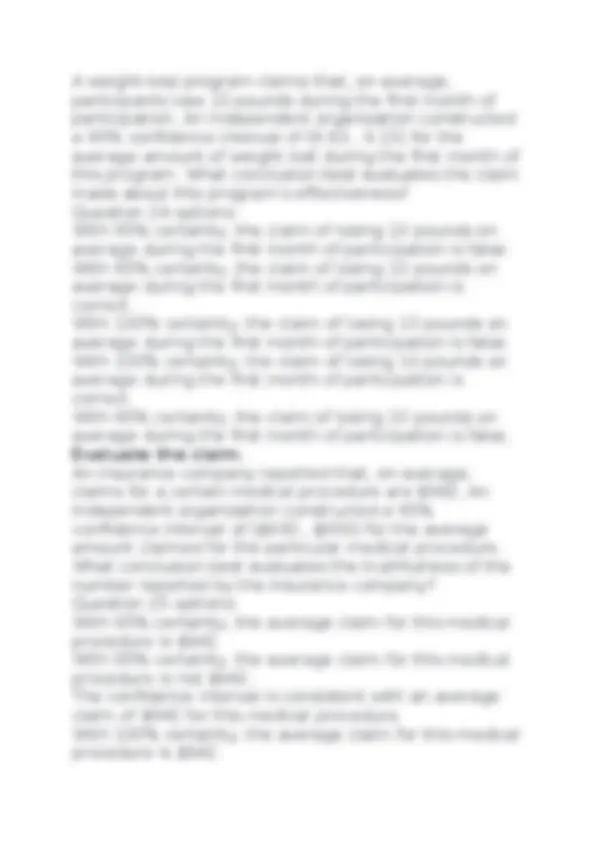

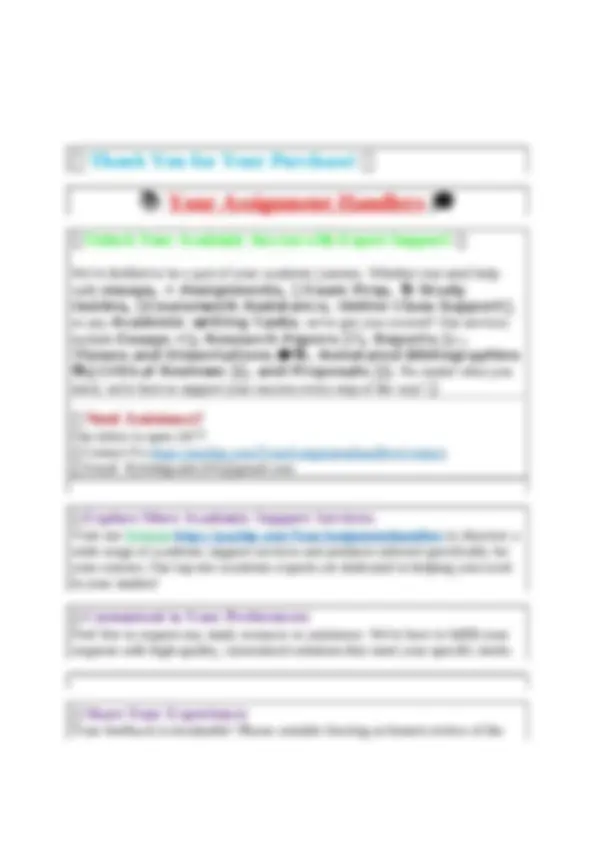
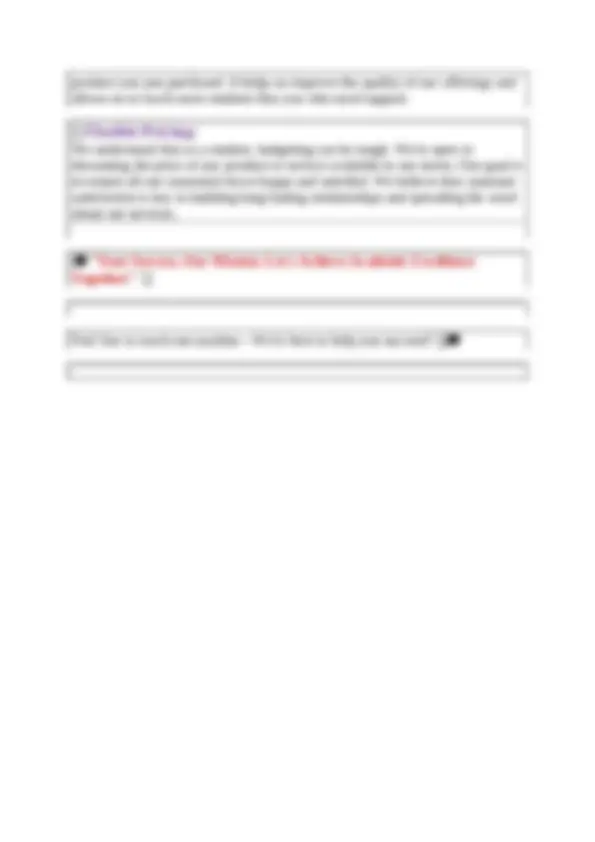


Study with the several resources on Docsity

Earn points by helping other students or get them with a premium plan


Prepare for your exams
Study with the several resources on Docsity

Earn points to download
Earn points by helping other students or get them with a premium plan
Community
Ask the community for help and clear up your study doubts
Discover the best universities in your country according to Docsity users
Free resources
Download our free guides on studying techniques, anxiety management strategies, and thesis advice from Docsity tutors
The key concepts and techniques in statistical inference, including the mean and standard deviation, the 68-95-99.7 rule, z-scores, hypothesis testing, effect size, statistical power, confidence intervals, and linear regression. It provides a comprehensive overview of the statistical methods used to draw conclusions from sample data and make inferences about the underlying population. The importance of understanding these statistical principles and their practical applications in various fields, such as psychology, economics, and social sciences. It also discusses the assumptions and limitations of these techniques, as well as strategies for interpreting and communicating statistical findings effectively.
Typology: Exams
1 / 33

This page cannot be seen from the preview
Don't miss anything!


























Course Title and Number: Statistics (Stat 2023) Quiz module 4 Exam Title: [Insert Exam Title] Exam Date: [Insert Exam Date] Instructor: [Insert Instructor’s Name] Student Name: [Insert Student’s Name] Student ID: [Insert Student ID]
Instructions:
**1. Read each question carefully.
What term refers to a frequency distribution that follows a bell- shaped, symmetrical, and unimodal curve? - Answer>> normal distribution In a normal distribution, the mean is located where? - Answer>> in the middle of the curve T/F For a normal curve, the median, mean, and mode are typically equal T/F The area below the curve is 120%. - Answer>> True False. 100% or 1. T/F The greater the standard deviation, the less spread out the normal curve. - Answer>> FALSE The greater the standard deviation, the more spread out the normal curve. The smaller the standard deviation, the narrower the normal curve. A normal distribution can be defined by its ___ and ______. - Answer>> mean and standard deviation the --___ rule con? - Answer>> 68-95-99. However, the rule only works when values are exactly 1, 2, or 3 standard deviations away from the mean. In order to apply the concept of proportions to other standard deviation values, such
Josef: X=87 - 1.75(4) = 80 Marco: X= 87 - 2.50(4) = 77 Brooklyn: X= 87 + 1.25(4) = 92 z-Scores for Sample Means from a Population - Answer>> (sample mean-population mean)/ population mean/ sqrt(sample size) Consider the example of the exam scores from Figure 4.3 ( μ = 75 , σ = 5 ). Suppose the teacher would like to know the proportion of scores on the exam that are below 65. - Answer>> 1. transform raw score to a z-score 2 use normal table to find the p-value for z score The proportion of scores below the z= -2.00 is 0.02275 or 2.275%. Therefore, a test score below 65 is unusual since less than 2.275% of the scores fall below it. a range of values that is likely to contain the true population mean. - Answer>> confidence interval What states that the distribution containing all sample means will approach the population mean. This implies that the population mean will be close to the sample mean. - Answer>> The Central Limit Theorem 95% confidence interval - Answer>> he 95% confidence interval, for example, means that 95% of the experiments with the given treatment will contain the true population mean. Consequently, 5% (or 1 in 20) of the experiments will not contain the true population mean. A 95% confidence interval implies that the researcher is 95% confident that the population mean lies in the interval that is centered around the sample mean. margin of error - Answer>> z crit *(population standard deviation/ sqrt (sample size)
T/F Hypothesis testing can determine the absolute size of the effect of the treatment. It can determine whether the treatment caused a substantial effect - Answer>> False. , it cannot determine the absolute size of the effect of the treatment. In other words, it cannot determine whether the treatment caused a substantial effect What researchers calculate to determine the absolute magnitude, or size, of the treatment. One measure for this is... - Answer>> effect size One measure for effect size is Cohen's d. cohen's d= mean difference/ standard deviation= (sample mean- population mean)/ s dev d=0. d=0. d=0.8 - Answer>> small effect medium effect large effect the probability of correctly rejecting a null hypothesis that is false - Answer>> statistical power Power = 1 - Beta - Answer>> In other words, if there is an effect, the power describes the likelihood that the study will provide evidence of the effect. Power is calculated prior to beginning a research study to define the probability of committing a Type II error (failing to reject a false null hypothesis) a value known as β. The statistical power of a study is measured on a scale of 0 to
A ______ test involves a directional hypothesis, whereas a ______ test involves a non-directional hypothesis. - Answer>> one-tailed, two-tailed What is the critical area? - Answer>> The area under the curve containing extreme values that rarely occur in the distribution. If the test statistic falls in the critical region, the result is statistically significant and you reject the null hypothesis. What is effect size? - Answer>> While hypothesis testing can determine statistical significance, effect size can tell us how meaningful or impactful a particular result is. Which of the following factors affects statistical power? Type of hypothesis test Significance level Effect size All of the above - Answer>> All of the above You are conducting an experiment that is expected to increase the mean scores for participants in the population. If the population mean is μ=75, which statement below is the correct alternative hypothesis (Ha ) for a one-tailed test?a. μ>75b. μ≥75c. μ<75d. μ≤75 - Answer>> A A sample of n =12 is selected from a population whose mean is μ=80 (σ=12). After a treatment is applied to the sample, the size of the treatment is d=0.25. What was the sample mean?a. =79b. =81c. =83d. =85 - Answer>> d=0. d= x-M/ sdev x= d(sdev) + M x= 83 C
In a study, how does the sample size affect the rejection of the null hypothesis and Cohen's d? Assume other factors are constant. A smaller sample size increases the likelihood of rejecting the null hypothesis and decreases Cohen's d. A larger sample size increases the likelihood of rejecting the null hypothesis and increases Cohen's d. A small sample size decreases the likelihood of rejecting the null hypothesis and does not affect Cohen's d. A larger sample size increases the likelihood of rejecting the null hypothesis and does not affect Cohen's - Answer>> d. A larger sample size increases the likelihood of rejecting the null hypothesis and does not affect Cohen's Why is it important to measure effect size? - Answer>> While hypothesis testing can determine statistical significance, effect size can tell us how meaningful or impactful a particular result is. What is a confidence interval? - Answer>> A confidence interval is a range of values that is likely to contain the true population mean. The 95% confidence level is the most common. What two things are used to calculate a confidence interval? - Answer>> Point estimate and margin of error a sample statistic that is used to estimate the population parameter e.g. x bar - Answer>> point estimate a range of values likely to contain the population parameter - Answer>> confidence interval 95% confidence represents - Answer>> range of values where you would fail to reject the null hypothesis
Since this is a two-tailed test at α = 0.05, zcrit = ±1.96.
What is the Pearson Correlation Coefficient? - Answer>> - The average product of two standardized variables How can normal variables x and y be transformed to standard normals? - Answer>> - Use the z-score transformation Properties of the Pearson Correlation Coefficient - Answer>> - r can take values between -1 and 1 ii: r = 0: no correlation ii: 0 < r < 1: positive correlation
All 3 of these are squared and summed at the end Least Squares Solution continued
b) *t tests of slope and intercept
So for F1, 18 that means the sample size is 20 because it will always be F1 and the 18 is from 20- So for F1, 58 that means the sample size is 60 because it will always be F1 and the 58 is from 60- t tests of coefficients - Answer>> - The null hypotheses are that: (1) slope = 0, and (2) intercept = 0 Reject null if t > tn-2, crit or if t < -tn-2, crit, where tn-2, crit is the critical value, generally the 95% probability point, of the t distribution with n- degrees of freedom 95% confidence intervals - Answer>> - The 95% confidence intervals of the regression coefficients are obtained from the standard error of each coefficient and the t distribution: Slope: b1 ± tn-2, crit SE(b1) Intercept: b0 ± tn-2, crit SE(b0) (SE: Standard Error) R2 goodness-of-fit - Answer>> - R2 is a summary measure of goodness-of-fit that is widely used
Remember: a) The denominator will ALWAYS be bigger than the numerator so that means... b) R2 can NEVER be greater than 1 and it will ALWAYS be between 0 - 1. c) The closer to 1, the better the model How to judge a model using R2 - Answer>> - In simple regression (1 DV + 1 IV), R is rigidly tied to the slope: R = β = r.